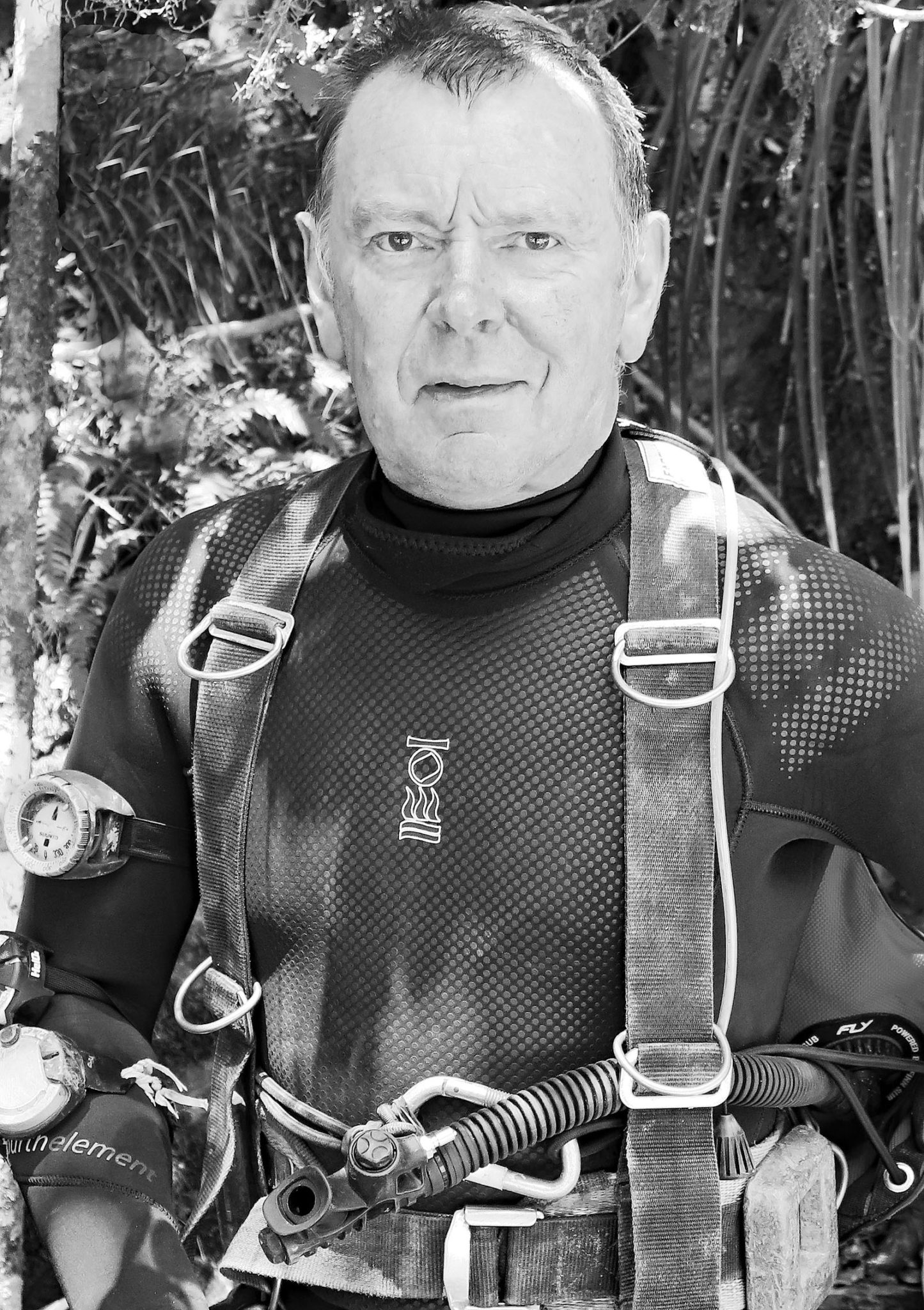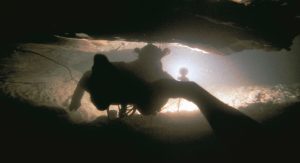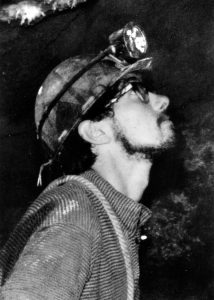
There are few cavers who won’t know the name of Martyn Farr, one of the world’s foremost cave diving experts. Martyn started caving in 1961 and took up cave diving nine years later. He is the author of numerous articles and about caving and caving diving and his latest book, The Darkness Beckons, a fully updated version of his original classic, is now available.
Martyn has kindly talked to Darkness Below about several of the close shaves he’s had while diving and what he’s learned from them!
“I’ve been caving since I was ten years old, and began cave diving when I was at university in 1970. Like the few other newcomers at the time, I was very much self-taught; I was young and felt pretty invincible. There was nothing I couldn’t climb underground, for example, and I was sure I could cut the mustard in cave diving as well. I’d got some gear together, which was minimalistic (one 26 cubic foot ‘tadpole’ bottle obtained from a Second World War crashed plane site and a single regulator) as I was an impoverished student; I was scrimping, doing it all on the cheap.”
Dan-yr ogof

My first close shave took place on my sixth cave dive in the summer of 1971, in Dan yr Ogof, South Wales. The dive was to be in the Mazeways part of the system where the potential was thought to be massive. Some friends had dived in this section a few years before and the results were inconclusive; there was scope for a determined diver to make headway.
I recruited two friends who had a similar level of experience to myself, and we had at least ten people to help get all the gear to dive base, which was about a mile (roughly an hour) into the cave.
I was due to make the first dive and a couple of people had suggested I take two sets of equipment, which wasn’t something I’d done before. So I kitted up and all that gear felt very unwieldy. So I thought, no; just one set will do.
In the water, visibility was about two metres, and the tunnel gradually descended down to about seven or eight metres (25 feet – we worked in feet back then). The passage was winding, twisting, with undercut sections to the sides. I was just trailing the line from my crude reel, using no anchor points, so inevitably it would pull into the undercuts – I just thought if it did that I’d have the presence of mind on the return to move to the side to pass the ‘line traps’.
Thirty metres (90–100 feet) in and about nine metres (30 feet) down I exhaled. And that was it: no incoming air. I’d never thought that this equipment could just stop working. There was an instant panic reaction – I didn’t even think to purge the mouthpiece of my regulator. I couldn’t think. I didn’t have the presence of mind that comes with familiarity. It was simple blind panic. I started swimming … like hell!
There was no air in my lungs, but I have a vivid memory of little bubbles of air, like drops of mercury, rolling up the outside of my mask. I quickly realised my finning was too slow and I started pulling on the line – which you should NEVER do! I pulled into one of the undercuts and came to a dead stop. Everything went calm … that was it. I breathed water. The fight for life ended. I had an out-of-body experience. I remember being jammed, and I remember looking back down on myself, thinking, ‘I’m dead’. I was out of air for what felt like minutes.
One of my mates on the surface felt the pulls on the line so another mate, Mike, kitted up and dived in. He saw my light, assumed all was OK, and went back out. After a while, when I’d not appeared, he dived back in. He came right up to me this time and somehow I drifted free from entrapment and followed him out. I will never be able to explain how. The guys on the surface dragged me out on to the sandy beach. I was purple, and coughing water; all energy spent. I’d been completely out of air for a few minutes.

Today I can clearly recall my post-dive thoughts: ‘What a fool I’ve been’, that I’d really embarrassed myself – not that I’d nearly died! Dejection, humiliation; yes, that about summed it up. There was a deathly silence at base. The thinking in our club at the time was that on any one cave dive there was reputedly a 10 per cent chance one could die. Hmm, the doom-mongers would have a bit more to say that night.
The two guys I was diving with said, ‘We’re never doing that again!’ and my mate Mike, a Navy diver, gave me all his gear. I spent the following Saturday at a river pool near Dan yr Ogof, practising, practising, practising – exhaling and then moving from one regulator to the other. Ironically enough, the regulator that failed was a US Divers Deep Star … which came with a ‘lifetime’ guarantee!
The hard lesson learned that day was that it’s essential to carry a second set of breathing equipment as any piece of kit can fail – and you must have a strategy if this happens.

Agen Allwedd, Roger Solari and the Rule of Thirds
The following year I started diving with a friend, Roger Solari, who had a similar level of experience to myself, and in 1972 and 1973 we found and explored miles of new cave in Wales and Ireland. In 1974 we decided we were going to tackle one of the most challenging sites in the British Isles – the terminal downstream sump in Agen Allwedd, in South Wales. On a dive in May 1974 I broke through a long sump into 500 metres of ‘dry’ cave that led down to another – undived – sump. A month later I was back with Roger to continue the exploration.

That this trip ended in tragedy is a story quite well known in caving circles, and it is covered in detail in The Darkness Beckons. We were diving together but operating as solo divers – we both knew the score: that either one of us could turn the dive at any point, that we were responsible for our own actions.
As I reached thirds, I decided to continue – thereby breaking the thirds rule – as it looked like the sump might shortly go to air. It didn’t, and Roger made the mistake of following me. The sump went up to perhaps only a metre’s depth and should by rights have reached air. If it had reached any kind of air, we’d have been fine. It didn’t; the stress of the situation was extreme. I turned and made it out, Roger didn’t.
The lesson I learned here was that one must respect and obey the internationally accepted thirds rule. Never since have I gone beyond thirds. When I’m training people I even suggest that they should aim to be more conservative still, for example turning around 10 bar before thirds.
Underground and underwater collapses
There have been other occasions in the intervening forty-plus years that have contributed to my experience, and a recent incident in France, in April this year, is a reminder to trust your experience and not push it when in a potentially risky situation. At a cave in the Lot, previous explorers had stopped at a boulder fall.
After three underwater digging sessions I ascended a narrow shaft for three to four metres to a point where I could just get my head, eye level, into air. I could see a big black space beyond two big boulders which blocked the route out of the water. I gave the first, smaller, block a push to see if anything could be done – standard caving practice. It moved, but then so did the one behind it as well. I instantly dropped down the shaft and dodged to the side. There was a big rumble as the blocks fell down the shaft behind me. I was very lucky; I knew from previous experience underground that the site was dangerous. But, as an explorer, I also had to know if anything could be done. Forty to fifty years of experience was crucial in this situation, and I’d had comparable situations in the past in dry caves. Miners down here in South Wales would say they could hear the coalface ‘walking’ before the collapse – a similar kind of experience.
So … stick within the accepted rules, don’t exceed the level of your training, develop your experience slowly and listen to that inner voice when things might not be going the way you planned. And look after your equipment. Keep it in tip-top condition. My kit might look beat-up, but it’s also very well looked after; I ensure my regulators and other gear are serviced regularly. Look after your equipment and your equipment will look after you.
